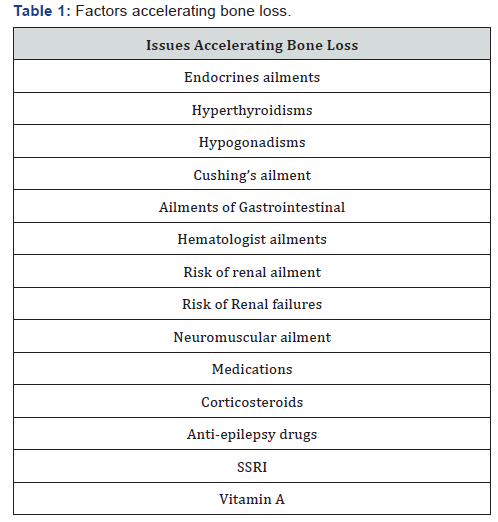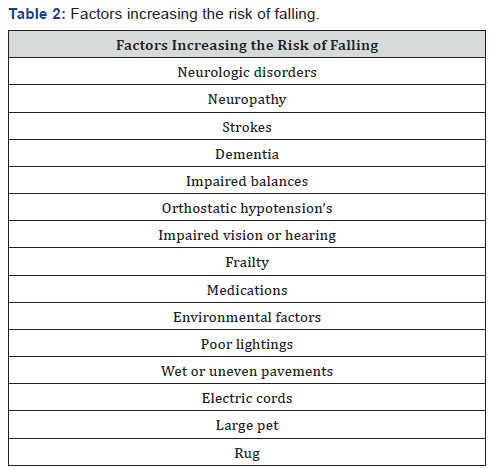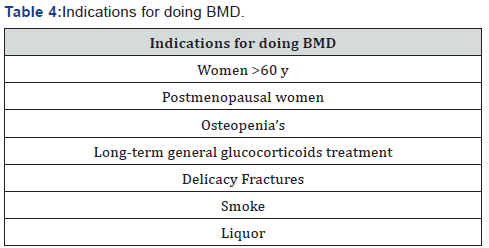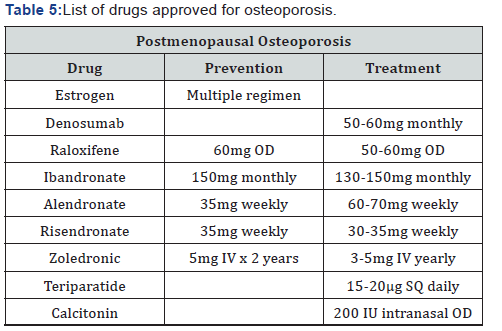- Research Article
- Abstract
- Introduction
- Pathophysiology of Postmenopausal Osteoporosis
- Clinical Features of Postmenopausal Osteoporosis
- Lifestyle and Non pharmacologic Measures for Bone Health
- Prevention of Risk Factors for Post-Menopausal Osteoporosis
- Treatment of Osteoporosis
- Conclusion
- Funding
- References
A Review of Effects and Medications for Osteoporosis
Ram Ishwar Yadav1*, Cao Yanming2, Ling Long1 and Jian Liang Gao1
Department of Orthopaedics, The Second Affiliated Hospital of Guangzhou Medical University, China
2Department of Surgery, Hue University of Medicine and Pharmacy, Vietnam
Head of Orthopaedic Department, The second Affiliated Hospital of Guangzhou Medical University, China
Submission: April 15, 2019; Published: August 09, 2019
*Corresponding author: Ram Ishwar Yadav, A senior resident in the second Affiliated Hospital of Guangzhou Medical University, Guangzhou 510260, China Open Access
How to cite this article: Ram Ishwar Yadav, Cao Yanming, Ling Long, Jian Liang Gao. A Review of Effects and Medications for Osteoporosis. Open Access J Surg. 2019; 11(1): 555801. DOI: DOI:10.19080/OAJS.2019.10.555801.
- Research Article
- Abstract
- Introduction
- Pathophysiology of Postmenopausal Osteoporosis
- Clinical Features of Postmenopausal Osteoporosis
- Lifestyle and Non pharmacologic Measures for Bone Health
- Prevention of Risk Factors for Post-Menopausal Osteoporosis
- Treatment of Osteoporosis
- Conclusion
- Funding
- References
Abstract
Osteoporosis is a type of condition having high chances of occurrence and spreading at a rapid way and it is increasing with the increase in the life expectancy of the general population. It is by far the commonest metabolic bone disease which is characterized by a diffuse reduction in the bone density due to decrease in the bone mass. Osteoporosis occurs when the rate of bone resorption exceeds the rate of bone formation. We know that now there is great advancement in the field of bone mineral density measurement, and it is conceivable now to work on early detection and rapid treatment which can help to recover early for the patient, and it may prove less harmful for the society as well.
Keywords: Bone Mineral Density; Osteoporosis; Climacteric
- Research Article
- Abstract
- Introduction
- Pathophysiology of Postmenopausal Osteoporosis
- Clinical Features of Postmenopausal Osteoporosis
- Lifestyle and Non pharmacologic Measures for Bone Health
- Prevention of Risk Factors for Post-Menopausal Osteoporosis
- Treatment of Osteoporosis
- Conclusion
- Funding
- References
Introduction
Osteoporosis can be termed as the silent condition which is rising in the recent time due to the growth in life expectation for the patients [1]. All of this will ultimately affect the physical, mental as well as the socioeconomic condition of the patient. Here we will work on summarization of the important aspects of this type of treatment. The working group of world health organization gave a definition which was totally built on the calculation based on T score of the BMD (Bone Mineral Density) and is said to be less than -2.45 and it can be considered as the osteoporosis [2].
The number of patients facing osteoporosis in them is rising in United State of America (USA) and it is expected that soon the number of patients will reach to figure of 34 million in USA [3]. The percentage of women is considered to be at 80 percent in total figure. The occurrence of osteoporosis increases with the age and there is rapid rise in case if females are facing menopause. The incidence of osteoporosis is also linked with the increase in occurrence of fractures which also work for the decrease in bone mineral density [4].
- Research Article
- Abstract
- Introduction
- Pathophysiology of Postmenopausal Osteoporosis
- Clinical Features of Postmenopausal Osteoporosis
- Lifestyle and Non pharmacologic Measures for Bone Health
- Prevention of Risk Factors for Post-Menopausal Osteoporosis
- Treatment of Osteoporosis
- Conclusion
- Funding
- References
Pathophysiology of Postmenopausal Osteoporosis
There are 2 causes of postmenopausal osteoporosis
i. Low peak bone mass
ii. Increase bone loss which is explained by 70% of genetic factors [5-8].
As soon as we will accomplish the peak bone mass, the rule of bone will take place by local remodeling, which is controlled by RANK, protein and OPG. Here Rank is a type of reception based of nuclear factor and is presented in the osteoblasts and works on increase their activity. It is synthesized by the osteoblasts and is blind with the Rank receptor based on osteoclasts. Whereas, OPG is also synthesized by the osteoblasts and works for the prevention of the binding of Rank by itself to RANKL(Receptor Activator of Nuclear Factor-kappa B ligand, the product of the TNFSF11 gene).
In females suffering from postmenopausal, hormones are changed with the increase in the RANKL which causes increase in the osteoclastic activity and the bone remodeling is shift towards the bone resorbing balance as it leads to osteoporosis. It has been noted that the bone loss is maximum 3 years before the menopause and even after 5 years of menopause. The loss of bone is faster than the average loss in bone in the senile osteoporosis which is mostly seen in males. The research also suggests the modification in micro architecture of the bone with the osteoporosis. Though the research and changers of quantification are still in experimental stages and they are not available for commercial use [9]. The factors which are accelerating the bone loss are discussed in Table 1 and the factors which rise the danger of tumbling and fractures are involved in the Table 2.


- Research Article
- Abstract
- Introduction
- Pathophysiology of Postmenopausal Osteoporosis
- Clinical Features of Postmenopausal Osteoporosis
- Lifestyle and Non pharmacologic Measures for Bone Health
- Prevention of Risk Factors for Post-Menopausal Osteoporosis
- Treatment of Osteoporosis
- Conclusion
- Funding
- References
Clinical Features of Postmenopausal Osteoporosis
The features of postmenopausal osteoporosis are:
i. Low bone mass which is measured by body mineral density
ii. Fractures are most important indicator of the osteoporosis
- Research Article
- Abstract
- Introduction
- Pathophysiology of Postmenopausal Osteoporosis
- Clinical Features of Postmenopausal Osteoporosis
- Lifestyle and Non pharmacologic Measures for Bone Health
- Prevention of Risk Factors for Post-Menopausal Osteoporosis
- Treatment of Osteoporosis
- Conclusion
- Funding
- References
Lifestyle and Non pharmacologic Measures for Bone Health
The goal of the therapy is given below
i. Prevention of the secondary bone loss.
ii. Prevention from fractures
iii. Preservation of skeletal structural integrity
iv. Optimization of skeletal growth to increase the peak bone mass
The diet plan which should be taken into consideration is given below:
Good general Nutrition: There is need of proper balance diet for the growth of good peak bone mass. It also depends upon the intake of protein as well as the activity level of the patient [10-12].
Calcium: The recommended dose of requirement of calcium on daily basis is different depending upon the situation and the details is given in Table 3. Some points are needed to be taken in consideration for the calcium as it is absorbed better with the food as well as with the calcium citrate which will give the least amount of GI side effects as compared to other compounds of calcium.

Vitamin D: It is a significant thing to work on the assessment of the all vitamins including Vitamin D in all the patient suffering from osteoporosis and Vitamins are available in food like fish oil. Mil, cereals and breads. As far as the recommendation of National osteoporosis foundation is concern, they have recommended a dose of 800-1000 IU for the patient less than 50 years old [13]. On the other hand, many experts suggest that the dose should be between 1000-2000IU and the safer limit for a human being is 4000IU per day [14]. The normal level is 30-32ng/ml and the upper limit is 60ng/ml [15]. Although the daily doses are present till it has been intermittent dose was found to be 3 times more strong [16].
Other dietary supplements: As we know that the magnesium will never increase the calcium absorption, but it will work for the decrease in GI side effects [17]. The excessive usage of Vitamin A was harmful for the bone because of usage in large doses which is more than 100000IU [18]. Vitamin K has been found as the source to work on decreasing the bone turnover and the decrease in bone loss [19]. It was expected that natural estrogens work for the prevention of bone loss, but no scientific evidence was found for it [20-22].
Alcohol: When someone will do excessive use of alcohol it will create bone loss. So, women suffering from postmenopausal should only take maximum of 7 drinks in a week [23].
Caffeine: The women suffering from osteoporosis should limit their caffeine to a level of 1 serving per day as it will work for decreasing the level of intestinal absorption of calcium [24].
Smoking: It is linked with the osteoporotic fractures and the patients will give up smoking as it is lesser risk container than for those who are active smokers [25].
Exercise: Exercise is necessary for human beings as the regular exercise of 30-40 mints will work for increasing the strength of muscles and it play the same role for increasing the strength of bones [26,27]. Though the patients suffering from high osteoporosis should avoid the heavy exercises like weightlifting and pulling or pushing.
- Research Article
- Abstract
- Introduction
- Pathophysiology of Postmenopausal Osteoporosis
- Clinical Features of Postmenopausal Osteoporosis
- Lifestyle and Non pharmacologic Measures for Bone Health
- Prevention of Risk Factors for Post-Menopausal Osteoporosis
- Treatment of Osteoporosis
- Conclusion
- Funding
- References
Prevention of Risk Factors for Post-Menopausal Osteoporosis
i. Imaging of spine so we can rule out of any type of fractures.
ii. Body mineral density is measured either at the spine or at the neck of the femur.
It is used for getting assessment for the expectation of fractures in the coming 10 years with the help of using the FRAX tool. Even, this type of modality is still expensive and the benefit for the society can be still not confirmed (Table 4).

- Research Article
- Abstract
- Introduction
- Pathophysiology of Postmenopausal Osteoporosis
- Clinical Features of Postmenopausal Osteoporosis
- Lifestyle and Non pharmacologic Measures for Bone Health
- Prevention of Risk Factors for Post-Menopausal Osteoporosis
- Treatment of Osteoporosis
- Conclusion
- Funding
- References
Treatment of Osteoporosis
All the applicants who require the treatment for the osteoporosis will include [28]:
i. spine fracture
ii. T score<-2.45
iii. T score should remain between +1 to -2.45 with an expectation of fracture and is calculated with the help of tool known as FRAX tool
All the medicines which are accepted for the dealing of postmenopausal osteoporosis have been listed and their dosage is shared at Table 5 as well as the possible effects of fracture risk reduction are mentioned in the Table 6. It was expected that the concomitant use of anti-osteoporosis drugs will work for the reduction of the fracture risk and it will be better than the using the single medicine [29]. Although, further research has work for the giving recommendation against the practice [30]. the consecutive use of drugs for the first anabolic group was followed by the anti-restorative drugs as they have been found to be the beneficial for the patients [31].


BMD in Progression of the Treatment
For the treatment of osteoporosis and prognosis; body mineral density is used. The treatment will never work and ultimately will fail if the substantial will fall in the body mineral density or if any other type of fracture occurs.
Operative Treatment for Osteoporosis
There are many fractures occurring, but the most common fractures are known with the name of vertebral fractures and there is always difference of opinion on the basis of the management of the same. Although the vertebroplasty will decrease the pain rapidly but it will never work for the increase in vertebral height to a normal level. On the other side, Kyphoplasty works for the increase in vertebral height as well as the reduction of pain but it is very expensive [32-36]. The specialist should be careful in the fixation of the other type of fractures with the help of using the locking plates as well as the HA coated implants for the purpose of providing a stable fixation.
- Research Article
- Abstract
- Introduction
- Pathophysiology of Postmenopausal Osteoporosis
- Clinical Features of Postmenopausal Osteoporosis
- Lifestyle and Non pharmacologic Measures for Bone Health
- Prevention of Risk Factors for Post-Menopausal Osteoporosis
- Treatment of Osteoporosis
- Conclusion
- Funding
- References
Conclusion
The research shows that the chances of occurrence of osteoporosis based on postmenopausal is on rise and one should work for the careful management and suitable medication should be given for proper treatment and fully recovery for every patient.
- Research Article
- Abstract
- Introduction
- Pathophysiology of Postmenopausal Osteoporosis
- Clinical Features of Postmenopausal Osteoporosis
- Lifestyle and Non pharmacologic Measures for Bone Health
- Prevention of Risk Factors for Post-Menopausal Osteoporosis
- Treatment of Osteoporosis
- Conclusion
- Funding
- References
Funding
National Natural Science Foundation of China (NSFC) 81574002.
- Research Article
- Abstract
- Introduction
- Pathophysiology of Postmenopausal Osteoporosis
- Clinical Features of Postmenopausal Osteoporosis
- Lifestyle and Non pharmacologic Measures for Bone Health
- Prevention of Risk Factors for Post-Menopausal Osteoporosis
- Treatment of Osteoporosis
- Conclusion
- Funding
- References
References
- Centers for Disease Control and Prevention (CDC) (2006) Fatalities and injuries from falls among older adults-United States, 1993-2003 and 2001-2005. MMWR Morb Mortal Wkly Rep 55(45): 1221-1224.
- Kanis JA, Melton LJ III, Christiansen C, Johnston CC, Khaltaev N (1994) the diagnosis of osteoporosis. J Bone Miner Res 9(8): 1137-1141.
- National Osteoporosis Foundation (2002) America’s Bone Health: The State of Osteoporosis and Low Bone Mass in Our Nation. National Osteoporosis Foundation, Washington, USA.
- Burge R, Dawson Hughes B, Solomon DH, Wong JB, King A, et al. (2007) Incidence and economic burden of osteoporosis-related fractures in the United States, 2005-2025. J Bone Miner Res 22(3): 465-475.
- Brown LB, Streeten EA, Shapiro JR, McBride D, Shuldiner AR, et al. (2005) Genetic and environmental influences on bone mineral density in pre- and post-menopausal women. Osteoporos Int 16(12): 1849- 1856.
- Recker RR, Deng HW (2002) Role of genetics in osteoporosis. Endocrine 17(1): 55-66.
- Williams F (2006) Genetic regulation of bone mass and susceptibility to osteoporosis. J Musculoskel Neuron Interact 6: 27-35.
- Richards JB, Kavvoura FK, Rivadeneira F, Styrkársdóttir U, Estrada K, et al. (2009) (Genetic Factors for Osteoporosis Consortium) Collaborative meta-analysis: associations of 150 candidate genes with osteoporosis and osteoporotic fracture. Ann Intern Med 151(8): 528-537.
- Seeman E, Delmas PD (2006) Bone quality-the material and structural basis of bone strength and fragility. N Engl J Med 354(21): 2250-2261.
- Misra M, Klibanski A (2006) Anorexia nervosa and osteoporosis. Rev Endocr Metab Disord 7(1-2): 91-99.
- Rizzoli R, Ammann P, Chevalley T, Bonjour JP (2001) Protein intake and bone disorders in the elderly. Joint Bone Spine 68(5): 383-392.
- Schürch MA, Rizzoli R, Slosman D, Vadas L, Vergnaud P, et al. (1998) Protein supplements increase serum insulin-like growth factor-I levels and attenuate proximal femur bone loss in patients with recent hip fracture: a randomized, double-blind, placebo-controlled trial. Ann Intern Med 128(10): 801-809.
- Dawson Hughes B, Heaney RP, Holick MF, Lips P, Meunier PJ, et al. (2005) Estimates of optimal vitamin D status. Osteoporos Int 16(7): 713-716.
- Ross AC, Manson JE, Abrams SA, Alois JF, Brannon PM, et al. (2011) The 2011 report on dietary reference intakes for calcium and vitamin D from the Institute of Medicine: what clinicians need to know. J Clin Endocrinal Metab 96(1): 53-58.
- Binkley N, Novotny R, Krueger D, Kawahara T, Daida YG, et al. (2007) Low vitamin D status despite abundant sun exposure. J ClinEndocrinolMetab 92(6): 2130-2135.
- Holick MF, Biancuzzo RM, Chen TC, Klein EK, Young A et al. (2008) Vitamin D2 is as effective as vitamin D3 in maintaining circulating concentrations of 25-hydroxyvitamin D. J Clin Endocrinol Metab 93(3): 677-681.
- Spencer H, Fuller H, Norris C, Williams D (1994) Effect of magnesium on the intestinal absorption of calcium in man. J Am Coll Nutr 13(5): 485-492.
- Jackson HA, Sheehan AH (2005) Effect of vitamin A on fracture risk. Ann Pharmacotherapy 39(12): 2086-2090.
- Braam LA, Knapen MH, Geusens P, Brouns F, Hamulyák K, et al. (2003) Vitamin K1 supplementation retards bone loss in postmenopausal women between 50 and 60 years of age. Calcif Tissue Int 73(1): 21-26.
- Alexandersen P, Toussaint A, Christiansen C, Devogelaer JP, Roux C et al (2001) (Ipraflavone Multicenter European Fracture Study). Ipriflavone in the treatment of postmenopausal osteoporosis: a randomized controlled trial. JAMA 285(11): 1482-1488.
- Atkinson C, Compston JE, Day NE, Dowsett M, Bingham SA (2004) the effects of phytoestrogen isoflavones on bone density in women: a double-blind, randomized, placebo-controlled trial. Am J ClinNutr 79(2): 326-333.
- Gallagher JC, Satpathy R, Rafferty K, Karnataka V (2004) The effect of soy protein isolate on bone metabolism. Menopause 11(3): 290-298.
- Kanis JA, Johansson H, Johnell O, Oden A, De Laet C, et al. (2005) Alcohol intake as a risk factor for fracture. Osteoporos Int 16(7): 737-742.
- Hallström H, Wolk A, Glynn A, Michaëlsson K (2006) Coffee, tea and caffeine consumption in relation to osteoporotic fracture risk in a cohort of Swedish women. Osteoporos Int 17(7): 1055-1064.
- Kiel DP, Felson DT, Hannan MT, Anderson JJ, Wilson PW (1990) Caffeine and the risk of hip fracture: the Framingham Study. Am J Epidemiol 132(4): 675-684.
- Snow Harter C, Bouxsein M, Lewis B, Charette S, Weinstein P, et al. (1990) Muscle strength as a predictor of bone mineral density in young women. J Bone Miner Res 5(6): 589-595.
- Snow Harter C, Bouxsein ML, Lewis BT, Carter DR, Marcus R (1992) Effects of resistance and endurance exercise on bone mineral status of young women: a randomized exercise intervention trial. J Bone Miner Res 7(7): 761-769.
- National Osteoporosis (2008) Foundation. Clinician’s Guide to Prevention and Treatment of Osteoporosis. National Osteoporosis Foundation, Washington, USA.
- Compston JE, Watts NB (2002) Combination therapy for postmenopausal osteoporosis. Clin Endocrinol (Oxf) 56(5): 565-569.
- Black DM, Greenspan SL, Ensrud KE, Palermo L, McGowan JA, et al. (2003) the effects of parathyroid hormone and alendronate alone or in combination in postmeno pausalosteoporosis. N Engl J Med 349(13): 1207-1215.
- Watts NB, Harris ST, Genant HK, Wasnich RD, Miller PD, et al. (1990) intermittent cyclical etidronate treatment of postmenopausal osteoporosis. N Engl J Med 323(2): 73-79.
- Anselmetti GC, Muto M, Guglielmi G, Masala S (2010) Percutaneous vertebroplasty or kyphoplasty. Radiol Clin North Am 48(3): 641-649.
- Röllinghoff M, Zarghooni K, Dargel J, Schlegel UJ, Siewe J et al. (2010) the present role of vertebroplasty and kyphoplasty in the treatment of fresh vertebral compression fractures. Minerva Chir 65(4): 429-437.
- Buchbinder R, Osborne RH, Ebeling PR, Wark JD, Mitchell P, et al. (2009) A randomized trial of vertebroplasty for painful osteoporotic vertebral fractures. N Engl J Med 361(6): 557-568.
- Kallmes DF, Comstock BA, Heagerty PJ, Turner JA, Wilson DJ, et al. (2009) A randomized trial of vertebroplasty for osteoporotic spinalfractures. N Engl J Med 361(6): 569-579.
- Shindle MK, Gardner MJ, Koob J, Bukata S, Cabin JA, et al. ( 2006) Vertebral height restoration in osteoporotic compression fractures: kyphoplasty balloon tamp is superior to postural correction alone. Osteoporos Int 17(12): 1815-1819.






























